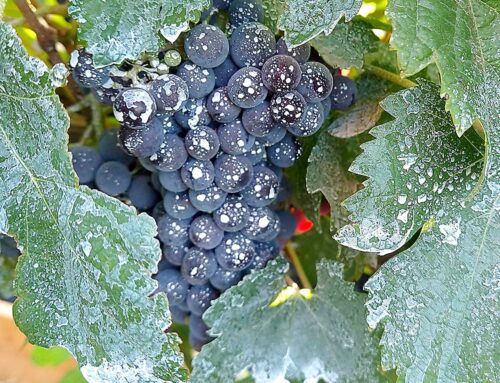
Dr. Michael Bush
All cherry growers should know how to identify cherry viruses in their orchards. Orchardists should be particularly concerned when they see decline-type symptoms spreading from branch to branch or tree to tree, says an extension educator. Most cherry virus symptoms are generic and not distinctive characteristics, said Dr. Michael Bush, Washington State University Extension, Yakima County.
Cherry decline, common in many orchards, can be linked to a variety of causes, including winter injury, micronutrient deficiency, and even summer oil sprays. But the same symptoms associated with cherry decline—stunted tree growth, small cherries, delayed maturity, and strange leaf growth or discoloration—can also be signs of diseases or viruses. “I encourage you to get worried when you see the symptoms spread from branch to branch or tree to tree,” Bush said during the Cherry Institute meeting in January.
Cherry decline can be also caused by bacterial canker. Look for cankers forming on the trunk, gummosis, bud blast, and shoot and branch die back. “If the reason for decline is bacterial canker, you’re lucky,” he said. “Because you can cure that.” Bush identified viruses of concern to Pacific Northwest cherry growers: Little cherry disease, Western X (buckskin) disease, cherry leaf roll virus, and cherry leaf roll virus combined with other viruses. Nearly all have generic symptoms, making visual diagnosis difficult.
Little cherry disease results in small, tasteless cherries and the leaves may curl and redden. Many years ago, the virus was a major problem in Washington’s Okanogan Valley, Bush said. Mealybug was suspected of being the vector in an outbreak of the disease in British Columbia, Canada. “This virus is lethal. It will kill the tree. And worse than that, this virus spreads from tree to tree,” he said. Little cherry disease may be trying to make a comeback. It was detected in a recent virus survey conducted in Washington State.
Western X disease was detected in the Yakima Valley in Van and Rainier trees during the 2003 virus survey. The mountain leafhopper is believed to be the vector. Symptoms include small, tasteless fruit with no aroma; pebbly, leather-skinned fruit; and sudden wilt and premature leaf drop. “It took two years for the grower to figure out what the problem was—and in the two years, the virus spread,” Bush added.
Cherry leaf roll virus, first detected in Washington State in 1997 in a single cherry tree on the Yakama Indian Nation, causes irreversible tree decline. It spreads from tree to tree by root grafting. The virus has been found in trees 12 years or older and in Bing, Van, Rainier, Chinook, and Lapins varieties. “The only solution for a cherry leaf roll virus-infected tree is to pull it out,” he said. “Infected trees do not recover.
Your goal is to prevent spread of the virus to adjacent trees.” Cherry leaf roll virus symptoms are very generic and may show up in one or several limbs. There might be heavy fruit set, but fruit is small and late in ripening. There might be early leaf drop—three weeks early—and leaves might be yellow. Not all cherry tree viruses are lethal, he noted. But when cherry leaf roll virus is combined with other viruses like Prunus necrotic ringspot virus and prune dwarf virus, the tree goes down even faster.
More pronounced symptoms are observed in Prunus necrotic ring spot and prune dwarf virus-infected trees when cherry leaf roll virus gets mixed in. When Prunus necrotic ringspot is combined with cherry leaf roll virus, fruit development is delayed, there is poor leaf development, and leaves may be cupped with white veins and enations. Bush said that “if you see white veins, that’s abnormal.” When cherry leaf roll virus is combined with prune dwarf virus, leaves remain in tight whorls or tufts on the branches. There may also be delayed or weak bloom in one limb relative to other limbs on the same tree. Loss of fruiting wood can occur.
Sampling
Bush advises growers to identify trees in decline in their cherry orchards and learn why they are declining. “I know that if you have an older orchard, you’ll find some cherry trees in decline. You need to find out why that is, because if it’s caused by a virus, it can spread.” He encourages growers to collect leaf samples and send them to WSU’s Irrigated Agriculture Research and Extension Center at Prosser for diagnosis.
Mark the tree so it can be found later. As part of a cherry leaf roll virus eradication program, the WSU lab will accept cherry leaf roll virus samples for $7. The lab continues to expand screening to other cherry viruses. Thus far, all of the trees infected with cherry leaf roll virus— more than 600—were removed by growers as part of the eradication program. It may take several years to eradicate the virus from your orchard, Bush warned. Once the infected tree is removed, growers must keep a close watch on the trees surrounding the infected tree. “It may take two to three years for the symptoms to show up in the other trees,” he said.
Bush recommended spraying the virus-infected stump with glyphosate and monitoring the adjacent trees for herbicide damage, indicating root grafting. Samples can then be taken of the adjacent tree, which will likely test positive for the virus.






Leave A Comment